Orthopaedic Research and Surgery
OPEN ACCESS | Volume 5 - Issue 1 - 2025
ISSN No: 2994-8738 | Journal DOI: 10.61148/2994-8738/JORS
Raúl Aragón Delgado
Orthopedic and Traumatology Hospital, “Dr. Rafael Moreno Valle” Puebla, Pue Mexico.
*Corresponding author: Raúl Aragón Delgado, Orthopedic and Traumatology Hospital, “Dr. Rafael Moreno Valle” Puebla, Pue Mexico.
Received: August 15, 2025 | Accepted: September 10, 2025 | Published: September 22, 2025
Citation: Raúl A Delgado. (2025) “Evaluation of Pain and Function at the Thigh Level in Patients Post-Operative Total Hip Arthroplasty with Long Conical Splined Stems vs. Cylindrical Stems with Extensive Porous Coating”. Orthopaedic Research and Surgery, 5(1); DOI: 10.61148/2994-8738/JORS/062.
Copyright: © 2025. Aragon Delgado, Raul. This is an open access article distributed under the Creative Commons Attribution License, which permits unrestricted use, distribution, and reproduction in any medium, provided the original work is properly cited., provided the original work is properly cited.
Abstract: Our objective was to assess thigh function and pain in postoperative total hip arthroplasty patients treated with uncemented, long, conical, fluted stems compared to cylindrical stems with extensive porous coating.
Materials and Methods: A descriptive, retrospective, prospective cohort study was conducted. A search of the hospital's database and case file numbers were analyzed from the hospital's opening (2016) to 2024. In the outpatient clinic, function was assessed using the Harris Hip Scale and pain was assessed using the visual analog scale at the thigh level.
Results: Regarding the Harris Hip Functional Scale, of the 48 revision prostheses, the following scores were obtained: good function (43.75%), favorable function (33.33%), excellent function (20.83%), and poor function (2.08%). The total number of patients with pain was 35.42%, and asymptomatic patients totaled 64.58%. Regarding pain, no statistical significance was found, with a p value of 0.76. Regarding functional results, statistical significance was found, with a p value of <0.021, and cylindrical stems with extensive coating are recommended for function.
Conclusion: Our study has allowed us to change decision-making patterns regarding the type of stem and provide recommendations based on pain and function achieved in our patients. We recommend establishing a Mexican national registry to obtain national data for conducting higher-level studies and providing scientific evidence.
postoperative; arthroplasty; thigh; cylindrical; conical; harris hip
Total hip replacement is a major surgical procedure with several complications and a mortality rate of 1–2%. (1) Sir John Charnley, the English orthopedic surgeon who developed the basic principles of the artificial hip joint, is considered the father of total hip replacement. He developed hip replacements in the mid-to-late 1960s. Approximately 500,000 THAs are performed annually in the U.S. alone. Primary total hip arthroplasty (THA) is expected to increase by 71% to 635,000 by 2030 (2). Test metals included gold foil and a cobalt-chromium-molybdenum (Co-Cr-Mo) alloy, which were later used as dental materials. The use of steel to repair cracks was documented by 1804 (3). By the 1950s, McKee and Ferrar introduced the first one-piece metal-to-metal joint, initially in stainless steel but later changing to Co-Cr-Mo (4). Cobalt alloys were accepted by the biomaterials community in the 1950s and early 1960s. The alloys currently used in orthopedics include mainly iron-based alloys (stainless steel), cobalt-based alloys, and titanium-based alloys (5). Recently, the mechanism of implant failure has become the subject of intense research as the life expectancy and lifespan of such implants are increasing (6). In 1988, approximately 11 million people in the United States owned at least one medical implant. Joints accounted for 44% of all medical implants. The proportion of people using a fixation device and joint prosthesis with one or more problems was 33.2% and 31.6%, respectively. The demand for such medical device implants is expected to increase in the coming years (7). Uncemented femoral stems were classified in 2011 by Khanuja et al. (8). In 2020, that classification system was modified by Kheir et al (9) to include short stems. These systems defined 7 major implant types, further broken down by stem geometry, cross-sectional properties, and surface characteristics. Although these classification systems allow for a structured discussion of cementless stems by their functional outcome, the specificity with which they classify stems based on geometry, cross-sectional properties, surface characteristics, and length makes it difficult to classify several new stems. The majority of cementless femoral stems are made of titanium, aluminum vanadium alloy, or cobalt-chromium molybdenum alloy, with the vast majority being titanium aluminum vanadium alloy. A randomized controlled trial of 423 primary THAs demonstrated that titanium stems are associated with lower rates of thigh stress and pain compared with cobalt-chromium stems (10). Albrektsson et al (11) demonstrated that osteoinduction, osteoconduction, and osseointegration resulted from the biocompatibility and lower modulus of elasticity of titanium alloy (100 GPa), which more closely resembles cortical bone (20 GPa) compared with cobalt-chromium (220 GPa). Despite typical excellent clinical outcomes, THA is often associated with less than physiological proximal load transfer and predominantly diaphyseal fixation. This phenomenon has been associated with thigh pain and proximal stress shielding, which, according to a study by Jo et al. (12), analyzed 240 primary uncemented THAs, occurring in 11.3% of patients. Both Ishii et al. and Nam et al. reported that poor canal filling along the stem is likely responsible for this insufficient osseointegration and subsequent thigh pain (13,14). Shorter stems were later introduced and may allow for more physiological proximal load transfer (15).
Material and Methods:
An ambispective, longitudinal cohort study was conducted. Patients postoperatively after total hip arthroplasty from 2016 to December 2024 were included. Patients were treated with long, splined, conical uncemented stems compared to porous-coated cylindrical stems. Patients were identified in the outpatient clinic of the joint department.
An exhaustive search was conducted in the operating room logbook and the hospital's medical archive to identify patients, schedule appointments with follow-up radiographs, and assess functional status and pain using the Harris Hip Score and the Visual Analogue Scale (VAS) for pain.
Results:
Our sample consisted of 48 patients, 52.08% women and 47.92% men, respectively, 25 women and 23 men (Figure 1).
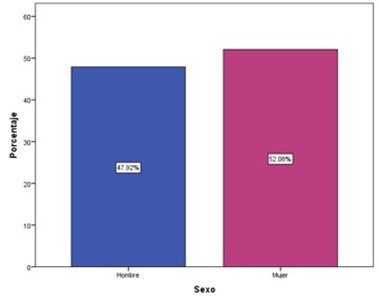
Figure 1: Shows the prevalence of gender, with the female gender having the highest prevalence.
Among the diagnoses reported at the first primary prosthesis surgery were hip osteoarthritis (47.92%), Hip dysplasia (6.25%), basal-vein fracture (12.50%), subcapital fracture (6.25%), transcervical fracture (18.75%), osteonecrosis secondary to fracture (6.25%), and cutout of a centromedullary nail (2.08%) (Figure 2).
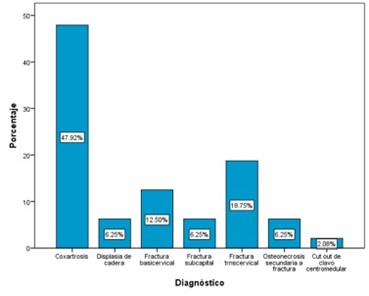
Figure 2: The diagnoses of the first primary prosthesis surgery are reported, with coxarthrosis as the most common preoperative diagnosis.
Among the etiologies for revision, there were periprosthetic fractures (31.25%) (15 patients in total), periprosthetic infections (27.08%) (13 patients in total), aseptic loosening (25%) (12 patients in total), and instability (16.67%) (8 patients in total) (Figure 3).
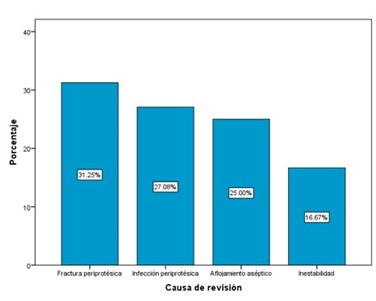
Figure 3:The etiologies of revision prosthesis surgery are reported. Periprosthetic fractures are reported to be the most common cause of prosthetic revision.
Among the outcomes for our dependent variables (pain and function). In the evaluation of pain of the revision femoral component with the fluted conical stem, a total of 24 postoperative patients were obtained, the asymptomatic patients represented were 31.25% and with pain 18.75%. In the end, this represents 50%. Regarding the femoral component revision with the cylindrical stem with extensive porous coating, a total of 24 postoperative patients were obtained. Within the reported results, 33.33% were asymptomatic and 16.67% had pain. This ultimately represents a total of 50%. Based on these results, pain was not statistically significant, with a p value of 0.76 (Figure 4).
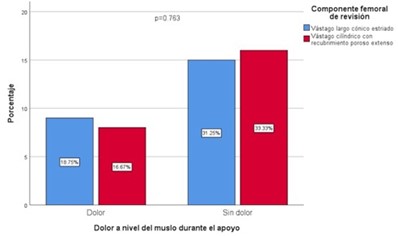
Figure 4: The image shows the pain assessment of the revision femoral component with a fluted conical stem versus a cylindrical stem with extensive porous coating. The results are not statistically significant.
The other dependent variable studied was function based on the Harris Hip Scale. When comparing different femoral revision components, our results showed a total of 24 patients with a fluted conical stem (50%) and 24 patients with a cylindrical stem with extensive porous coating (50%). Within the fluted conical stem, good function was achieved in 29.17% of cases, favorable in 16.67%, excellent in 2.08%, and poor in 2.08%. On the other hand, the cylindrical stem with extensive porous coating achieved good function in 14.58% of cases, favorable in 16.67%, and excellent in 18.75%. Based on these functional results, there is statistical significance, with a p < 0.021, and we recommend extensively coated cylindrical stems for function. (Figure 5)
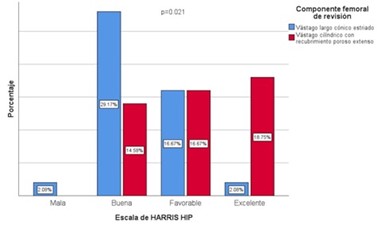
Figure 5: In the reported image, the variable studied was the function based on the Harris Hip scale, with the fluted conical stem vs. cylindrical stem with extensive porous coating, which have statistical significance and recommending cylindrical stems with extensive coating.
Discussion:
Regarding pain at the thigh level during support, in our results and previous studies there has been very little evidence when comparing one implant against another, however the onset time and duration of pain is a dependent variable that should be followed in all patients, in our study the incidence of pain in the thigh during support after a hip revision arthroplasty with the use of a fluted conical stem was 18.75%, compared to another study where its incidence was 11.3%. However, this study only compares a single etiology (proximal femoral osteonecrosis) as the etiology of conical stem placement, unlike our study that compares two implants, conical and cylindrical. Our results show 4 causes as revision arthroplasty, which are periprosthetic fracture, periprosthetic infection, aseptic loosening, and instability. So, this may influence the results as a cause of thigh pain, but a disadvantage of our study is not determining the time of pain during the evaluation in the outpatient clinic and the postoperative time as explained in this article (16). We must remember that there are reported risk factors for thigh pain in uncemented revision arthroplasty, such as stem size, elastic modulus, the position of the stem and osteoporosis that we must take into account to have a comprehensive approach to the patient. (16) and in our study we could not identify any risk factors already mentioned for thigh pain during support. Regarding function, there are articles that compare function and pain at the thigh level where they are not statistically significant in their results (17). However, our study compares two femoral components (conical and cylindrical), function (Harris hip scale) and pain (VAS). Where there is a statistical significance in relation to the Harris hip scale and thus recommend the cylindrical stem compared to the conical stem, which opens guidelines to several issues regarding our study, from the beginning of the fracture, primary disease, type of population, surgical technique and other factors that may be related to the surgeon, patient or medical institution.
Regarding length, there is no universal classification for defining stem length; therefore, the most current definition is related to the relative distance between the lesser tocanter and the distal tip of the implant. This is a disadvantage in our hospital population, as femur size is usually higher in the Mexican population, where this has already been studied. Based on this, in relation to the length of the stem size used in our study, the most frequently used revision stem was 190 mm, both conical and cylindrical. This could be one of the reasons for causing pain at the thigh level during support and functional evaluation. Some authors recommend a femoral component of 13.5 or more. (18)
Regarding the etiologies reported in our study in order of frequency are fractures (31.25%), infections (27.08%), aseptic loosening (25%) and instability (16.67%), compared to the Australian registry that has a frequency as follows aseptic loosening (25.6%), dislocation (21.06%), fracture (19.05%) and infections (17.7%). Other data in the joint national registry that includes England, Wales and Northern Ireland its main causes of revision is aseptic loosening. During the first postoperative year the dislocation, fractures and infection are the most common causes of revision, but aseptic loosening that occurs after the first year up to 10 years postoperatively. Another important registry is the Swedish that has a frequency reported as follows aseptic loosening (44.1%), followed by infection (19.5%). Fracture (13.6%) and instability (12.6%). It is important to keep these data in mind since there is no Mexican registry for follow-up. Clarifying this, knowing the time of progression and etiology in different parts of the world are different. One article concludes that the time of progression influences the etiology of revision arthroplasty, as is the case with dislocation and infection reported as a cause of revision in the first 3 years, aseptic loosening as a cause of long-term revision, and periprosthetic fractures in active older patients (19). Taking all of the above into account, we must consider some points as disadvantages in our study.
1. We did not determine the duration of pain during the outpatient evaluation or the postoperative period.
2. We did not identify any risk factors for thigh pain during weight bearing, as mentioned in previous articles.
3. The size of the femoral component in our hospital population (Mexican population) is a problem due to the definition of stem size.
4. We do not report the time course of revision arthroplasty, from primary surgery to revision.
5. We do not currently have a Mexican registry for revision arthroplasty, so this raises many questions to be answered and variables to be studied in relation to our results.
Conclusion:
As we have come to understand the risk factors, the etiologies of revision prostheses, and the multifactorial causes of thigh pain in postoperative patients, we must be very judicious in our medical-surgical decision-making and individualize the patient to determine the most appropriate femoral component. The longevity and quality of life of total hip arthroplasty has been demonstrated, so we must consider cost-effectiveness when making the decision. The initial approach, including a detailed clinical history, must be carefully considered to further reduce the risk of femoral component failure and prevent this potentially disabling pain. The failure of total hip arthroplasty is an increasingly common reason for reoperation. Added to this is the high cost for patients and healthcare systems. Our study has allowed us to change decision-making patterns regarding the type of stem and provide recommendations based on pain and function achieved in our patients. We recommend establishing a Mexican national registry to obtain national data for conducting higher-level studies with scientific evidence.